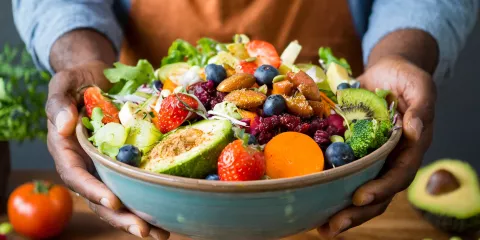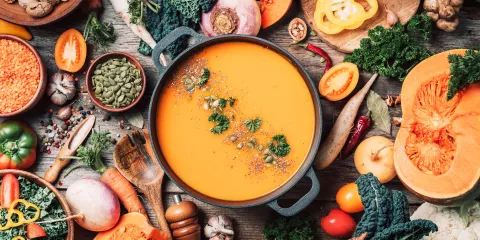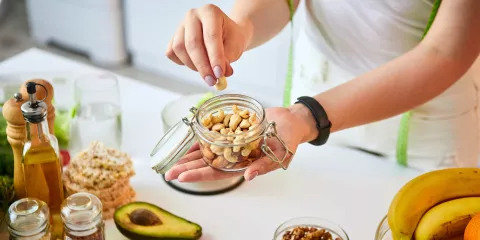
Summer is here, and you may be excited to enjoy the warmer weather! However, you may also be up against extreme heat waves, strenuous outdoor activities and strong, damaging sunlight.
In this post, we’ll talk about how to eat healthy during the summer. We’ll discuss what nutritious summer foods are available and give you some tips to improve your diet quality during the warmer months.
Summer Healthy Eating
To find the best produce right now, you need to know what foods are in season in the summer. Seasonal eating helps support local farmers, keeps costs at bay and gives you better tasting, more nutritious produce.
In the US, the following are at their peak in June, July and/or August:1
| Summer Fruits | Spring Summer |
|---|---|
| Apples | Beets |
| Apricot | Bell peppers |
| Avocado | Carrots |
| Banana | Celery |
| Blackberries | Corn |
| Blueberries | Cucumber (often cooked like a vegetable) |
| Cantaloupe | Eggplant |
| Cherries | Garlic |
| Honeydew melon | Green beans |
| Lemon | Lime beans |
| Lime | Okra |
| Mangoes | Summer squash |
| Peaches | Tomatoes (often cooked like a vegetable) |
| Plums | Zucchini |
| Strawberries | |
| Watermelon |
To see what foods are in season in your location, check out this seasonal food guide.
6 Tips to Eat Healthier This Season
Healthy summer eating is all about taking advantage of the fruits and vegetables that are available. It’s also about safety in hot weather. Heat exhaustion, syncope (fainting) and heat stroke can come on quickly – even in as little as 10-15 minutes – so be prepared.2 Luckily, your summer diet can help you beat the heat.
Let’s help make healthy eating a little easier with our top summer nutrition tips.
Related: Your Guide To Shopping at Farmer’s Markets
#1 - Look Beyond Water for Hydration
Fluid recommendations vary based on your health status, so be sure to discuss individual needs with your doctor or dietitian. However, typical water recommendations (on non-extreme heat days) are as follows:3-5
- Healthy men: 15.5 cups per day (with ~20% from food)*
- Sedentary men: 12 cups per day
- Healthy non-pregnant, non-breastfeeding women: 11.5 cups per day (with ~20% from food)*
- Sedentary women: 9 cups per day
Read more: 5 Ways to Drink More water Every Day
When the temperature climbs, you’ll need to stay extra hydrated. According to the CDC, those in the heat should hydrate before and after being outside as well as drink 1 cup of water every 15-20 minutes while outside.6 Water is a great choice, but you have options to diversify your fluid intake.
You can always reach for non-caffeinated and non-alcoholic drinks like seltzer, juice, milk and sports drinks. However, some of these options may have significant calories, fat and/or sugar, so read the label to understand what you’re drinking.
*Outside of beverages, reach for water-rich fruits and vegetables. Fruits such as watermelon, cantaloupe, strawberries and vegetables such as cucumber, tomatoes and celery are very high in water.3-4 These foods can contribute to your daily fluid intake, even as much as 20%.3
#2 - Go Plant-Based on the Grill
In the US, summer holidays emphasize grilling hot dogs and hamburgers. While it’s okay to enjoy those foods occasionally, it is recommended to limit consumption of red meats and processed meats as much as possible.7
Another issue with charred meat cooked over an open flame is the risk of heterocyclic amines (HCAs) and polycyclic aromatic hydrocarbons (PAHs). HCAs are muscle meat compounds that create the char on a burger. PAHs are compounds that occur when animal fat drips onto an open flame, smoke results, and the smoke adheres to the cooked meat. Research shows that HCAs and PAHs may be mutagenic, changing DNA and increasing cancer risk.8
Instead, take advantage of summer fruits and vegetables! Grilled peaches, corn and zucchini are wonderfully delicious options for your summer barbecue.
#3 - Limit Dehydrating Agents and Diuretics
Between the hot summer sun, heat waves and physical activity, it can be hard to stay adequately hydrated.
Caffeine is a diuretic and can contribute to dehydration. Found in coffee, tea, soda and energy drinks, it can increase urine output.6,9 Opt for decaf or non-caffeinated beverages to ensure the fluid you drink helps keep you hydrated.
Aside from caffeinated drinks, alcohol is also a diuretic.10 While you might enjoy a Long Island Iced Tea, you’ll probably find yourself urinating extra fluid, rather than holding it in for hydration purposes.6 Keep alcoholic beverages to a minimum, especially on hot days.
#4 - Keep Protein In Check
Protein is found in many foods, but those who consume excessive protein, especially via protein supplements, may be at heightened risk of dehydration.11-12
Too much protein (more than 35% of your calories) may put added stress on the kidneys, especially in people with insufficient kidney function.12-13
#5 - Make Fruit Your Dessert
We mentioned before that high-water fruits can help keep you hydrated on a hot summer day. To save on calories, fat and sugar, you can also make fruit your dessert.
A fresh bowl of strawberries or blueberries is an excellent choice. Fruit is hydrating, cooling and is lower in calories than typical summer treats such as cherry pie, ice cream and push-pops.
Try It Out: Strawberry-Mango Nice Cream
#6 - Focus on Key Seasonal Nutrients
It’s essential to get a variety of nutrients all year long, but you may want to pay special attention to certain ones in the summer. Try to include these key nutrients in your summer diet:
- Electrolytes: Electrolytes such as potassium, sodium, chloride and magnesium are especially important for hydration and proper body functioning. If you are active in the heat, especially for extended periods, replenish with a meal or sports drink.6
Even though it is best to get nutrients from real food, talk to your provider about your need for multivitamins and other nutritional supplementation.
References
1 US Department of Agriculture. Seasonal produce guide. SNAP Education Connection Website. Accessed January 30, 2023
2 Centers for Disease Control and Prevention (CDC). Heat stress - heat related illnesses. CDC Website. Updated May 13, 2022. Accessed February 14, 2023.
3 Gordon B, Klemm S. How much water do you need? Eat Right Website. Published June 23, 2022. Accessed February 14, 2023.
4 Fried School of Nutrition Science and Policy. Hydration: What to know for hot weather. Tufts Now Website. Published June 30, 2022. Accessed February 14, 2023.
5 Kleiner SM. Water. J Acad Nutr Diet. 1999;99(2). https://doi.org/10.1016/S0002-8223(99)00048-6
6 CDC. Heat stress: Hydration. CDC Website. Accessed February 14, 2023.
7 World Cancer Research Fund International. Limit red and processed meat. Accessed February 14, 2023.
8 National Cancer Institute. Chemicals in meat cooked at high temperatures and cancer risk. NIH Website. Published July 11, 2017. Accessed February 14, 2023.
9 Zeratsky K. Do caffeinated drinks, such as coffee or energy drinks, hydrate you as well as water? Mayo Clinic Website. Published January 12, 2023. Accessed February 14, 2023.
10 Dworkin RW. Why alcohol makes you pee. GoodRx Health Website. Published October 10, 2022. Accessed February 14, 2023.
11 Academy of Nutrition and Dietetics (AND). How teen athletes can build muscles with protein. Eat Right Website. Published July 21, 2020. Accessed February 14, 2023.
12 Wempen K. Are you getting too much protein? Mayo Clinic Website. Published April 29, 2022. Accessed February 14, 2023.
13 Cuenca-Sanchez M, Navas-Carrillo D, Orenes-Pinero E. Controversies surrounding high-protein diet intake: Satiating effect and kidney and bone health. Adv Nutr;6(3):260-266












